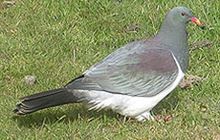New Zealand pigeon / kererū / kūkū / kūkupa
Introduction
The kererū is a large bird with iridescent green and bronze feathers on its head and a smart white vest. The noisy beat of its wings is a distinctive sound in our forests.New Zealand status: Endemic
Conservation status: Not Threatened
Population: Widespread throughout the country
Found in: Forested areas, particularly where there is pest control
Threats: Predation, habitat loss
Sound recording:
New Zealand pigeon/kererū/kūkū/kūkupa (MP3, 1,868K)
01:58 – Three adults in song and in-flight wingbeats (cicadas in the background).
Species information: New Zealand pigeon on NZ Birds Online
New Zealand pigeon/kererū conservation
Our native pigeons
There are two species of native pigeon:
- New Zealand pigeon (Hemiphaga novaeseelandiae) known as kererū, or in Northland as kūkū or kūkupa
- Chatham Islands pigeon (Hemiphaga chathamensis) or parea
Kererū can measure up to 51 cm from tail to beak, and weigh about 650 g. Parea are around 20% heavier.
While kererū are not threatened, parea are considered nationally vulnerable. New Zealand pigeons on Raoul Island (Kermadecs) became extinct in the 19th century, presumably due to predation by feral cats.
Did you know?
Chicks are fed "pigeon milk", a protein-rich milky secretion from the walls of the parents' crops, mixed with fruit pulp.
Important seed dispersers
Since the extinction of the moa, the kererū and parea are now the only bird species that are big enough to swallow large fruit, such as those of karaka, miro, tawa and taraire, and disperse the seed over long distances. The disappearance of these birds could be a disaster for the regeneration of our native forests.
Threats
Nationally, the kererū population is considered to be stable but its numbers are gradually declining in areas where predation and illegal hunting are unchecked.
That decline has been offset due to recovery on predator-free offshore islands, or from large-scale recovery at sites with widespread pest control, particularly near large urban centres.
Although the kererū was traditionally hunted for its meat and feathers, hunting of the bird is now illegal.
The most serious threat to the kererū comes from predators. Recent studies in several parts of the country have found that many nests produce no fledglings at all. Rats, stoats, cats and possums eat their eggs and nestlings; stoats and cats will also attack and kill adult kererū.
Possums also compete with adult kererū for food (leaves, flowers, fruit) and devastate trees by consuming new shoots. Forest clearance and poaching are also threats to its survival. Research by the Department of Conservation, Landcare Research, universities and other groups has found that the species is unlikely to cope with hunting pressure.
In Northland, the kūkupa is in danger of becoming locally extinct through the combined effects of predation, competition and continued hunting.
Our work
The Department of Conservation carries out large-scale pest control operations. These assist the recovery of kererū by killing the predators that prey on their eggs and chicks. By controlling rats and possums, kererū populations can increase by 50 percent in two years.
We are also involved in educating the public about the plight of the New Zealand pigeon and encouraging local initiatives to save it.
In Northland, we have been working with local iwi to help stop illegal poaching of the kūkupa by educating young Māori about the disastrous effect this is having on the birds' survival rate.
You can help
There are lots of ways you can protect kererū in your region:
- Control predators by trapping or poisoning. If you find an occupied nest and trapping/poisoning is not an option, band the tree and interconnecting trees to exclude predators.
- Consider planting trees to feed the kererū. Tree lucerne is useful in the short-term as it flowers prolifically in winter, has nutritious leaves, and grows quickly; for a long-term solution, plant miro, titoki, tawa, fuchsia, kōwhai, five-finger, pate, pigeonwood, taraire, puriri and wineberry.
- Do not hunt kererū.
Find more ways to get involved by visiting these websites:



